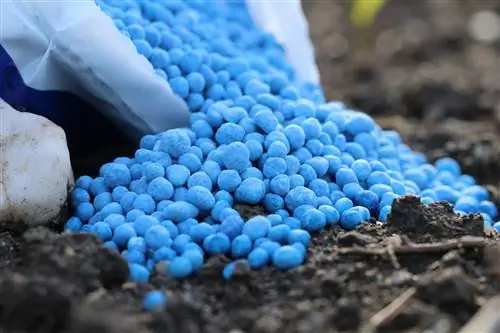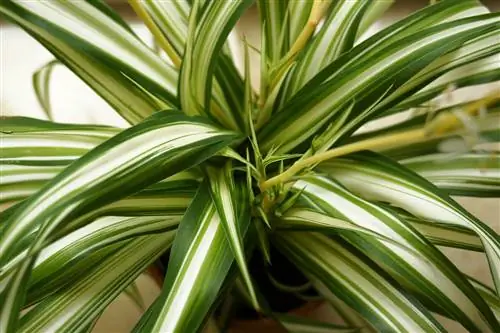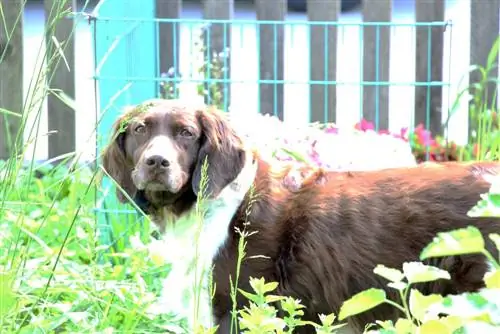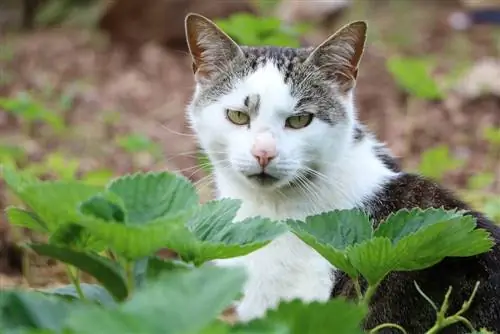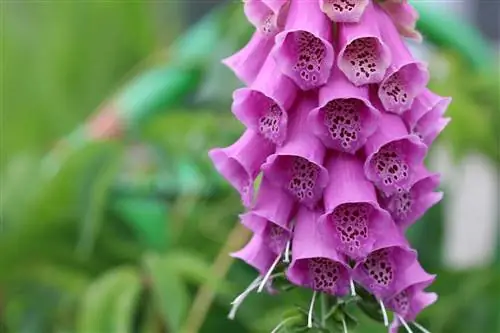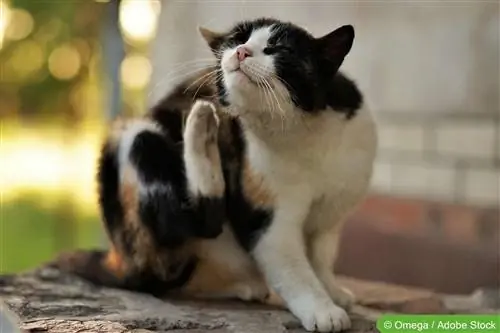- Author admin [email protected].
- Public 2023-12-17 03:39.
- Last modified 2025-01-24 12:45.
The use of blue grain is widespread in home gardens, but this spherical fertilizer is produced purely chemically and poses a major he alth risk. Concerned parents with small children should better use organic fertilizer to prevent he alth damage. If pets are allowed to move freely in the garden, their safety must also be ensured; if necessary, Blaukorn should only be used in separate areas. In addition, chemical fertilizer has no place in organically managed gardens.
Bluegrain
The name blue grain is derived from the blue color of the fertilizer, which is very similar to slug pellets, but serves a different purpose. The fertilizer contains the most important nutrient elements, which are crucial for plant growth. However, the chemically produced blue grain contains no organic material and therefore does not provide food for the living creatures in the soil, which are urgently needed for the earth. The following characteristics account for the widespread fertilization success of blue grain:
- not a natural fertilizer, designed entirely on a chemical basis
- promotes plant growth and ensures a richer harvest
- in spherical shape available from specialist retailers
- listed as an all-round fertilizer
- contains nitrogen, magnesium, phosphorus and potassium
- depending on the manufacturer, trace elements may also be included
- individual granulate balls gradually dissolve on their own
- Active ingredients are released into the plant soil in doses
- ensures a long-lasting supply of nutrients for the plants
- it takes a long time for the ingredients of the blue grain to break down
- extremely toxic in high doses, small amounts can only cause minor damage
- not suitable for organic gardens
By the way: The components of the Blaukorn fertilizer get into the groundwater with irrigation and rain water, so that these pollutants are subsequently contained in small doses in the drinking water of households. It is therefore better to work with organic fertilizer, even if the growth success is lower.
Toxicity to humans
Since blue grain is a chemical fertilizer, people experience symptoms of poisoning after contact, which depend on the intensity of the contact. If the blue grain beads are accidentally consumed, severe symptoms usually occur, especially in the gastrointestinal tract. The following symptoms of poisoning are characteristic of contact and consumption of blue grain:
- poisonous to humans, especially small children
- scattered around the garden area, children often pick them up and use them to play with
- only gradually seeps through the water into the ground
- Possible symptoms: cramps, severe diarrhea with bloody parts, prolonged vomiting, extreme breathing difficulties up to total circulatory collapse
- Nitrogen contained in fertilizer inhibits the oxygen supply
- extreme irritation of the mucous membranes, recognizable by the blue color
- In high doses there is a great danger to he alth, even coma
- takes a long time to completely break down from the ground
- Danger of poisoning exists for some time
Tip:
As a fertilizer pellet, the blue seed looks relatively harmless and, with its unusual color, is particularly appealing to children who like to put new and unknown things in their mouths. That's why the product must always be stored safely; ideally, it is not used in the garden at all.
Toxicity to animals
Blue grain used as fertilizer is also toxic to dogs and cats, as well as to all other pets that are allowed to move freely in the garden, for example rabbits or hamsters. Sheep and goats are also at risk if they are kept next to plants fertilized with blue grain. The symptoms of poisoning are similar to those in humans and are quite comparable to them. Pets come into contact with blue grain much more quickly than people, as they are almost constantly in contact with the ground. The following aspects should be taken into account when poisoning pets with blue grain:
- Pets often walk through the scattered blue grain
- Afterwards they lick their paws
- Small animals nibble on plants fertilized with blue grain and eat them
- Consumption causes severe irritation in the stomach and intestinal tract
- common symptoms: cramps, extreme diarrhea, vomiting, rattling breath, circulatory problems
- irritated mucous membranes with significant discoloration
Emergency measures
Due to the high risk to he alth, both for humans and pets, countermeasures must be taken as quickly as possible to avoid long-lasting damage. If the fertilizer dosage is kept low, no irreparable consequential damage is to be expected. However, the situation is different with an overdose, in which case consumption can even cause a coma. Therefore, if you are poisoned, you should not hesitate and seek professional help immediately:
- If poisoning is suspected, see a doctor immediately
- the veterinarian is responsible for animals
- In an emergency, go to the hospital to take countermeasures promptly
- if it comes into contact with mucous membranes, rinse immediately with plenty of water
- Don't stop vomiting, ideally the chemical substance is excreted by the body
Alternatives
When using blue grain, the contamination of the garden soil with nitrogen and nitrate increases, a negative process for the entire ecological cycle. In addition, the groundwater is also extremely polluted, so that the poison ultimately ends up in the food and drinking water. It is therefore highly recommended to use a fertilizer that is harmless to humans and animals. The following fertilizers can be applied without any concerns:
- Always prefer ecologically compatible fertilizers to chemical fertilizers
- ideal alternatives are: manure, green manure, horn shavings, manure, compost, straw, etc.
- organic commercial fertilizers: sewage sludge or compost from composting operations
- Specialist retailers offer a wide range of organic fertilizers
Conclusion of the editors
Due to the possible risk of poisoning, blue grain should only be used in garden areas that are not used by people and animals. Small children and curious dogs and cats in particular search through all the beds and quickly come into contact with the chemical fertilizer. In small doses, blue grain only causes minor irritation, but increasing the dosage can lead to severe poisoning. Blue grain has no place as a fertilizer in a family garden, just as it does in an organic cultivation. To be on the safe side, there are many organic fertilizers that pose no risk and also protect the environment. Ultimately, every chemical fertilizer ends up in the human body, either through the food grown or through the groundwater contaminated with it.
What you should know about the toxicity of blue grain in brief
- If you have pets such as dogs, cats, sheep or goats, you should not use blue grain as fertilizer if possible.
- Here it is advisable to get a lighter and more harmless fertilizer for the garden that cannot harm the animals.
- You can now also get blue grain variants, which are largely harmless.
In contrast to the previously available products from the fertilizer department, today's blue grain products are significantly less dangerous, but still just as effective. They mainly contain magnesium and zinc, both of which benefit the growth of the lawn. The environmentally friendly version of blue grain also reduces the nitrate content, which means that the groundwater is only influenced to a small extent and the quality of the lawn also increases at the same time. The general argument for using blue grain is that it is extremely effective and contains the substances necessary for the garden. The negative aspect is often that it contains too much nitrate and phosphate, which can be dangerous for living beings.
- If you want to prevent poisoning at all costs, you should use a substitute that works just as well as blue grain.
- There are special fertilizers that are just as effective, but have less phosphate in them. They are commercially available.
- Horn shavings are also an alternative; they cannot be dangerous to cats and dogs under any circumstances.
The general rule for blue grain is: An application is not automatically toxic or even dangerous for humans and animals, but only if the concentration and amount used is too high. How much Blaukorn you need without risk and for what occasion can be found on the package insert. There are also relevant safety and application instructions so that the Blaukorn fulfills its purpose and purpose, but at the same time is not used in excessive amounts. If the latter were to happen, the time period in which the ingredients of the blue grain have to be broken down would be very long and the garden would no longer be usable for children or pets for a long time.

